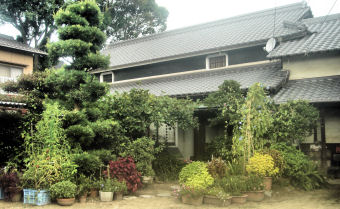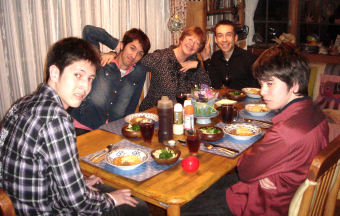From Fast Food to Fresh Fish
January 2012
Tales of Transition
By Wendy Jones Nakanishi
My three sons were horrified when I presented them last year with a T-shirt inscribed with the slogan “McDonald’s is Evil.”
We live in Japan but I am American. I had returned to my home state of Indiana to visit aged, ailing parents and chanced upon a shop personalizing shirts. On impulse, I decided on a present for my boys that I, at least, found entertaining.
“We like McDonald’s! Our friends will laugh! They like McDonald’s, too.”
“Don’t worry,” I breezily counseled them. “Hardly any of your friends can read English well enough to have any idea what the words mean.” Even my Japanese husband, who is fairly fluent, was dubious about the meaning of “evil.”
But my children weren’t convinced. They only wore my gift under duress, and I sometimes found the shirt wadded into a ball, stuffed in the back of the clothes cupboard. Their reluctance stemmed primarily from allegiance to their favorite fast food restaurant. Japan is no longer primarily a country a land of sushi and its components, rice and raw fish. In recent years it has become a prime purveyor of “junk” food. Every medium-sized town has its McDonald’s and Kentucky Fried Chickens, its Baskin Robbins and Pizza Huts.
I can understand the attraction. As a single mother looking after us four children in small-town Indiana, my mother was an indifferent cook. She was not only unskilled but also uninterested in the whole process of making meals. She jumped at any opportunity to shirk the bothersome duty. She often took my brother and sisters and me to local root beer stands and hamburger joints where we delighted in all the delicacies on offer. We loved the warm buns cradling succulent, thick patties, their salty meatiness offset by slices of tomato and lettuce, with the tastes of beef and vegetables blended into a heavenly concoction by liberal lashings of mayonnaise, ketchup and mustard. Soft drinks were the perfect accompaniment, offering a study in extremes: the cold beverage, the hot food, and the intense sweetness of the drink contrasting with the saltiness of the food.
My husband, Takehito, has always been dismayed by what he perceives as my “bad food” habits and, equally, has always balked at pandering to them. He refused, for example, to bring me a McDonald’s takeaway on the three occasions when I was recuperating in hospital after the birth of our sons. He ascribes my deplorable tendencies to my being an American: a regrettable circumstance but scarcely one that can be altered or amended. As a Japanese, he was raised in a far different way than I had been, and his ideas about food and about eating, like those of most of his generation, have scarcely been touched by the recent emergence of fast food joints in Japan, which are most popular with Japanese teenagers and young families.
Japan consists of four main islands and innumerable tiny ones. We live on the smallest, most rural of the four: Shikoku. Visitors to Japan often comment on the prominent role food plays in this culture. Japanese television broadcasts many cooking programs as well as those showing young, attractive girls traveling about the country, sampling regional culinary delights. There is a kind of reverence for food in Japan, attributable both to its native religion, Shinto, which perceives the presence of God in all of nature, as well as to the widespread starvation following the second World War.
Takehito belongs to a family that has farmed in our area for hundreds of years.
Takehito’s parents inhabit a traditional old Japanese farmhouse or noka constructed many years ago. According to Japanese custom, the eldest son in a farming family is expected to remain in the family home, sharing the dwelling with his parents, assisting them with the agricultural chores, and taking over the farm when they grow too old to work any longer. When the son marries, his new wife joins him there. She must assume a subservient role in the household, waiting on and serving her in-laws. I have been exempted from this general rule as I am a foreigner, and my husband and I live in a log house down the road from Takehito’s parents.

The traditional Japanese farmhouse is a black, squat, two-story building stooping under a thatched or, latterly, a heavy tiled roof. Its structure and support columns are made of wood, with the columns and crossbeams intricately interlocked, with the use of only a few nails. Its walls are completed with the addition of bamboo and clay. It sits in a dusty courtyard enclosed by high stone walls. Few rooms inside have fixed walls; some contain scarcely any furniture. Sliding panels or wood-and-paper screens,_ fusuma_, can be added or removed to make larger or smaller spaces as the occasion or necessity requires. The floors are covered with tatami mats.
Takehito recalls that when he was a child, the area of the kitchen reserved for the preparation of food had a hard dirt floor where his mother and grandmother discarded vegetable and fruit peelings as they cooked. There was no refrigerator or stove, and electrical equipment was limited to a single light bulb dangling from the ceiling. His mother and grandmother cooked over a wood-burning brazier made of bricks. The main dish of every meal was rice, and the huge pan of it cooked on the brazier in the morning would be used by nighttime. Takehito fondly describes a dark, smoky place; as a little boy, he was expected to collect twigs and branches from the mountainsides for the kitchen fire and for the fire that would heat the family bath.
After twenty-three years’ residence in this country, I have come to conclude that the best of Japanese cookery represents a triumph of making a virtue of necessity. With no gas or electric stoves at their disposal, former generations of Japanese perfected the art of grilling and roasting meat and fish, in stewing vegetables over a low flame, and in preparing exquisite platters of raw fish and vegetables. With no refrigerators or freezers to store food, they became adept at pickling a wide variety of vegetables to complement the daily fare of rice. Left-over rice was mixed with vinegar, to preserve it, with the vinegar-flavored rice serving as the basis of sushi. Sweets were provided in the form of dried fruit; in autumn, it is still not uncommon to see a line of dried persimmons strung out like a festive if unseasonable line of yellow Christmas-tree bulbs on the porch of a Japanese farmhouse.
When I compare my childhood to my husband’s, I have mixed feelings. My siblings and I grew up with plenty, free to wander the aisles of well-stocked grocery stores that offered anything we might long for. The problem was convincing our mother to buy and to cook it for us. Takehito talks of having had to share a single egg with his brother at breakfast when they were children: the rest of the eggs provided by the family’s chickens needed to be sold. But my acquaintance with fish was limited to tinned tuna and sardines, while Takehito was offered a huge range of seafood. Like all Japanese, he is adept at de-boning the most spiny of fish with a few deft movements of his chopsticks. His favorite is Pacific saury, a long, thin silvery fish served whole – its beady black eyes staring sightlessly from the head and its finny tail intact – with a drizzling of soy sauce and a mound of grated “dakikon,” giant Japanese radish, on the side. For my husband, it is a special treat, and he insists on preparing it himself, broiling one for each of us. While I labor over my fish and sometimes must resort to a knife and fork, Takehito dispatches his quickly and efficiently, radiating contentment, leaving a cleanly-picked skeleton on his plate. I prefer the buttery sweet flesh of yellowtail; my children like smoky mackerel, its strong flavor undercut by ginger slices, while my mother-in-law often presents us with one of her specialties: turbot stewed in fish stock.
Naturally, my husband, a farmer, has always advocated the use of the freshest ingredients possible. Takehito grows mandarin oranges, tangerines, limes, and a large, fleshy, thick-skinned fruit resembling a grapefruit called “dekopon” that I have never seen outside Japan; he also used to grow hothouse muscat grapes. He and his mother maintain a large vegetable garden, which supplies us with cucumbers, tomatoes, potatoes, onions, leeks, lettuce, and daikon. Takehito occasionally grows strawberries for us in a corner of one of his greenhouses, and a long line of fig trees borders the orange grove. Our neighbors, farmers themselves, often present us with gifts of the kiwi fruit, loquats and persimmons they grow.

In terms of “healthy eating,” I think my boys have been very fortunate to have spent their childhood in Japan. Not only is it the norm for the average Japanese housewife to do a “daily shop” to buy the freshest ingredients possible for her home-made meals, but the lunches provided by the nursery schools and kindergartens and secondary schools here are of an exceptionally high nutritional standard and, I can confirm from personal experience, wonderfully tasty. To my chagrin, when they were little, my children occasionally asked me why I couldn’t cook such wonderful meals as those they had at school.
The ingredients are locally sourced and prepared, but the typical school menu is the same throughout the country. There is always a small bottle of milk and a bowl of hot steaming white rice. There is usually some kind of soup or stew. There are vegetables – stewed or boiled or served as a salad – and fish or meat and a piece of fresh fruit. On special occasions, one of my favorite dishes might be featured: a savory steamed egg custard with shrimp, mushrooms, and a gingko nut inside.
But it is not only Japanese food that is on offer in the school lunches. There is also spaghetti and pizza and curry, salads and cream soups and rolls, all freshly prepared each day at each school. A menu of the month’s meals, including pictures of each day’s offering, is sent home with each child, and our youngest boy, the most interested in food, enjoys poring over it, anticipating his favorite dishes. When I ask him which meal he is most looking forward to, he always tells me that everything is delicious.
Like my mother, I am not a particularly skilled let alone an inspired cook, but I do my best. I prepare both Japanese and western food for my family. We have rice and miso soup flavored with chunks of tofu, slices of shiitake mushrooms, and strands of seaweed nearly every day. The typical Japanese meal, whether breakfast, lunch, or dinner, centers around the staple bowl of rice. All the other dishes provided are considered secondary. These include, traditionally, miso soup, broiled fish or grilled meat, stewed vegetables and pickles. Each food item is served separately, on or in its own dish. The typical Japanese housewife is a technician and an artist. She can rapidly slice vegetables with razor-thin precision. She can transform tomatoes into rosettes and fashion cucumber twirls and carrot curls.
I also indulge my own food preferences, inherited from my Indiana childhood, by baking casseroles and making pots of chili and vegetable soup and, each Friday night, popcorn. Occasionally, I try to cook “ethnic” dishes, wanting my boys to experience something of the world’s wonderful variety of food. We have Italian nights, with spaghetti bolognese and garlic bread. I cook curries, served with raita and pappadums. I make tacos, accompanied by fried beans. My family particularly likes my British-style “fry-ups,” including eggs, sausage, bacon, salad, and a slice of toast, served up on one large plate.
I know that I represent an object of curiosity to my neighbors and relatives here, who surreptitiously inspect my shopping basket should we happen to meet at the grocery store, and who seem to invent pretexts to drop by at meal-times to find out what the local “foreigner” provides her family and how she serves it to them. My practices are gratifyingly odd to them.
My ambition is to make dinnertime not only a regular feature of our household routine but also an event, an occasion rather than just an institution. There are always candles on the table and jazz playing in the background. My husband and I drink wine. We encourage discussion of the day’s events. We chat and complain, laugh and moan. It feels like life itself, or a celebration of it.
I am averse to extremism of any type or variety. I was raised on fast food and am fully aware of its attractions. I suppose my own change of heart occurred when my children were young boys and I began to think of the consequences of an unhealthy diet. Many of my American relations suffer from diabetes; I determined to try to protect my sons from such a fate as far as it lay in my power. In any case, my boys and I have reached a happy compromise. I buy soft drinks once every two or three weeks for them, and every couple of months, I take them to a McDonald’s in the neighborhood. We all find it comical. The children know that, no matter what the weather, I will insist on sitting in the car to wait for them, refusing to compromise my integrity by entering. I know that they will buy and eat as much “junk” food as humanly possible. They emerge looking satiated and content and just slightly guilty.
But I worry about their future, when my boys become husbands and fathers. I’ve adopted the role of the traditional Japanese wife and mother. I manage nearly all the cooking and most of the housework. I wait on my children “hand and foot.” On the few occasions when my sons have needed to prepare their own lunch or dinner, I return home to find empty polystyrene containers of “Pot Noodles” littering the kitchen table. I am haunted by the cautionary tale presented by the son of a Japanese friend who went away to university in Tokyo and had his own tiny flat there. He had no notion of cooking for himself and gained a great deal of weight, becoming dangerously ill because he subsisted on the bentos or pre-packaged meals he bought every day at the local convenience store. A bento looks healthy and inviting but it is anything but; it is full of salt and sugar and chemical additives.
The answer to my worries about my boys’ lack of culinary competence may exist in the unlikely medium of computer technology. My eldest son has bought a Nintendo game that teaches cooking. The program features mostly Japanese dishes, but the globalization of the world’s cuisine has affected even insular, homogenous Japan, with the Nintendo illustrating, for example, the preparation of spaghetti. All the recipes are displayed, all the ingredients listed, and, given Japan’s sexism, it is an appropriately feminine voice that intones instructions on the preparation techniques. In high-tech Japan, with its love of gadgets, it somehow seems appropriate that my boys may be saved by science.
I have three boys who belong to Japan in a way I never could, whether I wished to or not. They love Japan and lament the inaccessibility of Japanese food whenever we venture to other countries. I sometimes grieve that my sons can never “really” know my own childhood culture of the American Midwest and that, in a sense, as a “gaijin” or foreigner in Japan, I am reduced to being an onlooker at theirs, but I know I have influenced my children in many ways. My eldest boy in particular likes the dishes I occasionally make when seized with nostalgia for my past. He eagerly devours fried chicken, mashed potatoes and gravy, corn on the cob and popcorn, and my husband laughs, saying that I have converted him. Equally, my family has transformed me, and I make miso soup and rice each day like the good Japanese housewife they expect me to be.
My children may not live in Japan forever. After all, my Japanese husband spent three years in Africa and their American mother has lived in Britain, France and now Japan. But wherever my three boys end up, I hope they will remember the food of their childhood: its odd mixture of the cuisine of Indiana and Japan with an occasional flavoring of ethnic foods. When the boys venture into adult life and leave not only the family home but, perhaps, even Japan behind, they will find McDonald’s wherever they go. I imagine they will be amused by the recollection of my refusal to frequent such places and, perhaps, they may even adopt a similar resolution. If this is the case, I will feel I have satisfactorily prepared my sons to make their own forays into the world and its food.
© 2011 by Wendy Jones Nakanishi. All rights reserved.
Wendy Jones Nakanishi has lived in Japan for over thirty years, teaching full-time at a small private college on the rural island of Shikoku. Her academic interests include eighteenth-century English literature, journals, diaries, and the works of Jane Austen, John Ruskin, Virginia Woolf, Iris Murdoch, and modern Japanese novels. Wendy has just published a murder mystery set in Japan: Imperfect Strangers, under the pen name of ‘Lea O'Harra.’ Enjoy a thrilling story while learning from the author’s deep knowledge of Japanese culture:



